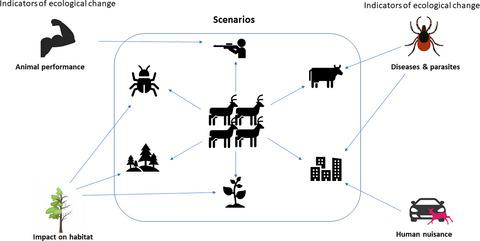当前位置:
X-MOL 学术
›
Mammal Rev.
›
论文详情
Our official English website, www.x-mol.net, welcomes your feedback! (Note: you will need to create a separate account there.)
Wild ungulate overabundance in Europe: contexts, causes, monitoring and management recommendations
Mammal Review ( IF 4.9 ) Pub Date : 2020-09-20 , DOI: 10.1111/mam.12221 Antonio J. Carpio 1, 2 , Marco Apollonio 3 , Pelayo Acevedo 1
中文翻译:

欧洲野生有蹄类动物数量过多:背景,成因,监测和管理建议
更新日期:2020-09-20
Mammal Review ( IF 4.9 ) Pub Date : 2020-09-20 , DOI: 10.1111/mam.12221 Antonio J. Carpio 1, 2 , Marco Apollonio 3 , Pelayo Acevedo 1
Affiliation

|
- High‐density populations of large ungulates are now widespread. However, the perception of overabundance only appears when it produces a problem for humans, such as a loss of plant diversity, damage to agricultural crops and forestry, ungulate‐vehicle collisions, a nuisance to humans, disease transmission to livestock or changes in habitat for other species. The admissible level of density depends on the ecological and socio‐economic context in which the population is located, and defining this level is important, in order to determine management strategies and actions.
- We describe the main contexts in which ungulate overabundance occurs in Europe, record the causes of overabundance and evaluate which set of indicators of ecological change is the most appropriate for monitoring and diagnosing overabundance in each scenario.
- Our review of 318 published papers revealed six contexts of wild ungulate overabundance in Europe (protected areas, hunting areas, forestry, arable farming, livestock farming and [peri]urban areas). In addition to population abundance, four sets of indicators of environmental change could be used to monitor overabundance within these contexts (impacts on habitats, impact on animal performance, increments in diseases and parasite loads, and increments in nuisance to humans).
- Nine species of ungulate were found to be overabundant. Red deer Cervus elaphus was the species most likely to be overabundant in the contexts of protected areas (detailed in 27% of papers on that context) and hunting areas (38%); roe deer Capreolus capreolus in forestry (28%); wild boar Sus scrofa in arable farming (60%), livestock farming (29%) and (peri)urban areas (38%). Our evidence shows that the diagnosis and monitoring of ungulate population overabundance via indicators of ecological change, and the management actions required to control these undesirable situations, are strongly context‐dependent.
中文翻译:

欧洲野生有蹄类动物数量过多:背景,成因,监测和管理建议
- 高有蹄类动物的高密度种群现在很普遍。但是,只有在对人类造成问题时才会出现过剩的感觉,例如植物多样性的丧失,对农作物和林业的损害,有蹄类动物的车辆碰撞,对人的滋扰,疾病向牲畜的传播或栖息地的变化等。其他物种。允许的密度水平取决于人口所处的生态和社会经济环境,因此,确定该水平很重要,以便确定管理策略和行动。
- 我们描述了在欧洲发生有蹄类动物过量的主要情况,记录了过量发生的原因,并评估了哪种生态变化指标最适合在每种情况下监测和诊断过量发生。
- 我们对318篇已发表论文的评论揭示了欧洲野生有蹄类动物过多的六种情况(保护区,狩猎区,林业,可耕种农业,畜牧业和城市周边地区)。除了人口丰富之外,在这些情况下(环境对栖息地的影响,对动物性能的影响,疾病和寄生虫负荷的增加以及对人类的滋扰的增加),可以使用四套环境变化指标来监测过量。
- 发现九种有蹄类动物过多。马鹿马鹿是种最有可能overabundant在保护区和狩猎区(38%)(在关于这方面的论文27%详述)的环境; 林业Cap鹿(28%);野猪(Sus scrofa)在可耕种(60%),畜牧业(29%)和(周边)城市地区(38%)中。我们的证据表明,通过生态变化指标对有蹄类动物种群过多进行诊断和监测,以及控制这些不良状况所需的管理措施,在很大程度上取决于环境。



























 京公网安备 11010802027423号
京公网安备 11010802027423号